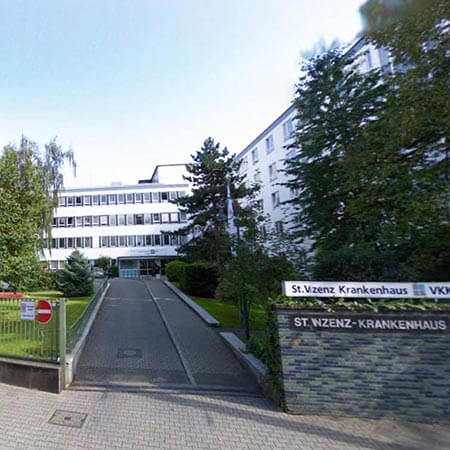Ankle Arthritis — Total Ankle Replacement: treatment in the Best Hospitals of Germany
Treatment prices are regulated by national law of the corresponding countries, but can also include additional hospital coefficients. In order to receive the individual cost calculation, please send us the request and medical records.

Department of Adult and Pediatric Orthopedics, Foot Surgery
The Department of Adult and Pediatric Orthopedics, Foot Surgery offers the widest range of modern medical services to patients suffering from musculoskeletal diseases. The department specializes in knee and hip replacement surgery, including revision interventions to replace previously implanted artificial joints. The department has the status of a certified Maximum Care Endoprosthetics Center (endoCert), which means adherence to the requirements of European professional societies for carrying out procedures of this kind, a high level of safety and treatment efficiency. It is worth noting that the department uses the innovative ROSA® robotic system for performing knee replacement surgery. A special Rapid Recovery Program is used for the rapid recovery of mobility after joint surgery, which allows the patients to quickly return to their usual life. An integral part of the department's clinical practice is also the treatment of foot diseases and deformities in adults and children. The medical facility has been operating for more than 50 years, and therefore it provides patients with the highest quality medical care and easily copes even with highly severe pathologies.




Department of Adult and Pediatric Orthopedics, Trauma Surgery, Foot Surgery, Hand Surgery and Rheumatology
The Department of Adult and Pediatric Orthopedics, Trauma Surgery, Foot Surgery, Hand Surgery and Rheumatology offers the full range of diagnostic and therapeutic services in its areas of specialization. The key areas of work of the department's doctors include large joint arthroplasty, arthroscopic interventions on the knee, hip, and shoulder joints, conservative and surgical treatment of foot and hand diseases and deformities, rheumatic joint lesions, orthopedic diseases in children, and musculoskeletal injuries. The key to successful clinical practice is the professionalism and unique experience of the department's medical team, combined with the advanced infrastructure and state-of-the-art equipment. The department has 5 operating rooms equipped with the latest technology. Most surgical interventions are performed using minimally invasive techniques, due to which, in the shortest possible time, the patient is verticalized, their mobility is restored, and a pronounced pain syndrome is excluded. The department annually performs more than 4,500 surgical interventions, including especially complex ones, so the specialists at the medical facility are rightfully proud of their impressive clinical experience in the surgical treatment of orthopedic diseases. Over the years, the department has gained an excellent reputation not only in Germany but also far beyond its borders.





Department of Adult and Pediatric Orthopedics
The University Hospital Ulm is an advanced medical complex that provides patients with high-class medical care using the very latest scientific achievements. The medical facility has been performing successful clinical activities for more than 40 years and has long earned an excellent reputation throughout Europe. The hospital regularly demonstrates high treatment success rates, takes an active part in the training of medical students, and works tirelessly on promising research projects. The university hospital consists of 29 specialized departments and 16 scientific institutes, where more than 7,000 highly qualified employees work for the benefit of their patients. More than 55,000 inpatients and about 300,000 outpatients are treated here every year. The hospital has 1,274 beds. The medical team of the hospital is focused on providing personalized medical services using the most modern and sparing diagnostic and treatment methods.






Ankle arthritis causes pain, impaired joint mobility and sharply limits the physical activity of the patient. At the advanced stage of the disease, the pathology has to be treated with surgery. One of the best treatment options is surgical replacement of the ankle joint with an artificial endoprosthesis.
This is a relatively rare surgical procedure, and most doctors have no experience in performing it. Therefore, it is better to go abroad for ankle replacement. In this case, you can count on the best long-term results. Approximately half of all ankle replacement procedures performed in Europe are carried out in Germany. Orthopedic surgeons in this country use the very latest types of endoprostheses, which are implanted with perfect precision. After surgery, patients receive high-quality care and rehabilitation.
To undergo treatment in Germany, please use the services of Booking Health. Here you can get information about the cost of treatment, compare prices and book a medical program at an affordable price.
Content
- Who may need a total ankle replacement?
- Principle of the treatment method
- Types of ankle endoprostheses
- Joint replacement in modern hospitals
- Why is it worth undergoing treatment in Germany?
- Treatment in Germany with Booking Health
Who may need a total ankle replacement?
The main indication for ankle replacement is primary or post-traumatic arthritis. Less often, operations are performed for severe injuries, tumors, and inflammatory lesions of the ankle joint.
Ankle replacement surgery for arthritis is not considered a standard surgical treatment. Most patients undergo arthrodesis. During this operation, the bones that form the ankle joint are connected with screws, needles or pins. As a result, mobility in this place is completely blocked.
Such an approach allows the doctors to solve a number of problems, first of all, it relieves a person from chronic pain and joint instability. Arthrodesis stabilizes it and makes it possible not only to walk, but even to run. This type of intervention is considered best for young patients who are physically active.
However, arthrodesis has several disadvantages. These include:
- Functional deficit that is especially noticeable when walking or running fast.
- The foot and ankle are involved in walking, and when the ankle joint ceases to function fully, the load on the foot increases sharply, leading to the development of metatarsal and tarsal joint arthritis.
- Long-term immobilization of a limb – a person must spend several weeks with a cast, which complicates further recovery and leads to muscle atrophy.
- The load on the knee and hip increases, so the risk of developing arthritis in these joints increases as well (the likelihood that the patient will need replacement in the future increases).
The treatment of ankle arthritis with replacement surgery does not have these disadvantages. Common ankle replacement is a technically complex operation, which is not always successful, but it provides better functional outcomes. When walking, the leg moves naturally, so there is no increasing stress on the adjacent joints. New types of endoprostheses can serve for decades. When they are implanted in a good hospital, the risk of complications and unfavorable functional outcomes is minimized.
Total ankle replacement is substitution of the diseased ankle joint with an artificial prosthesis.
Cost of ankle arthritis treatment with total replacement is from €6,181. You can find prices for other treatment options on the Booking Health website.
The best hospitals in Germany are:
- University Hospital Rechts der Isar Munich
- Vitos Orthopedic Clinic Kassel
- University Hospital of Ludwig Maximilian University of Munich
- University Hospital Ulm
- University Hospital Frankfurt-am-Main
Principle of the treatment method
The essence of the procedure is that the doctor implants an artificial joint instead of the patient's own. He removes the tissues affected by the pathological process. The components of the endoprosthesis are implanted instead.
The ankle joint has a complex structure. It is formed by three bones: talus, tibia and fibula. Its movements and stability are influenced by many soft tissue anatomical structures: ligaments, muscles and their tendons, a connective tissue capsule. For this reason, it was not possible for a long time to create endoprostheses that could completely restore the function of the ankle.
In the second half of the 20th century, the doctors obtained excellent results in knee and hip replacement. It turned out that endoprostheses serve for a long time, completely eliminate pain and restore limb function. They hoped that the creation of endoprostheses for other joints would help to obtain the same results, but the doctors were wrong.
The first successful total ankle replacement was performed in 1970. The authors eventually performed surgery for 25 patients and described the outcomes, but they were unsatisfactory: they achieved good functional results in only 7 cases. Over 10 years of observation, the components of the endoprosthesis loosened in 12 patients, while the stability of the artificial ankle joint was impaired.
The following artificial joints were even worse. At the end of the twentieth century, there were many failures, but in the end, high-quality endoprostheses were created. They are mainly made in Europe (France, England, Germany). In total, about 50 models of ankle endoprostheses have been developed in the world, but only about 15 of them are used in ankle surgery.
Total ankle replacement is a relatively rare surgical procedure in medicine, especially when compared with surgical interventions to replace other large endoprostheses. Hundreds of thousands of knee and hip replacement surgeries are performed every year in Europe. At the same time, total ankle replacements are performed only 3,000 times a year, about 1,500 operations of which are performed in Germany.
Such interventions are very rare in countries with a poor level of medicine. For example, only about 50 ankle replacement surgeries are performed every year in Russia. Most orthopedic surgeons, even among those who specialize in replacement surgery, have never performed or seen ankle replacement surgery.
Types of ankle endoprostheses
There are two types of endoprostheses for total ankle replacement. These are:
- Unconstrained.
- Constrained.
Whenever possible, doctors give preference to unconstrained ankle prostheses. Information obtained from clinical trials demonstrates that these types of artificial joints are more reliable. However, they cannot be implanted in all patients. In significant damage to the soft tissue structures, it is necessary to resort to the use of constrained endoprostheses.
By the type of movement, artificial joints can be:
- Single-axis.
- Polyaxial.
The last ones provide the best function of the limb. Their implantation is especially preferable for patients with a stiff hindfoot. After the implantation of this type of endoprosthesis, the supination and pronation of the foot are restored, which reduces mechanical stress, prevents loosening and increases the service life of the prosthesis.
Constrained prostheses are rarely used, only in the most severe cases, in elderly patients with low physical activity. They cannot stand an active lifestyle. Stabilizing systems compensate for the deficiency of their own ligamentous apparatus, but complications after the implantation of such endoprostheses develop more often. The most common problems are pain or impingement syndrome caused by rubbing of the prosthesis and ankles. The prosthesis wears out quickly: after 9 years, revision surgery is required in 40% of patients.
Joint replacement in modern hospitals
Advances in modern medicine have made it possible to successfully perform even such a complex surgical procedure as total ankle replacement. Important conditions for achieving a good result of the surgery are high-quality endoprosthesis of the very latest generation and an experienced team of surgeons.
Modern endoprostheses are functional and resistant to loads. They take into account the biomechanical features of the ankle joint. The new types of prostheses have artificial polyethylene menisci. They are made from a cobalt-chromium alloy with a porous coating on the surfaces in contact with the bone. The metal is coated with calcium phosphate for good bone adhesion. Some endoprostheses have lateral planes on the talus component, which protect the articular cartilage of the ankles – they are suitable for patients with significant damage to the lateral ankle joint. Most modern endoprostheses are fixed using a cementless technique.
It is very important that a total ankle replacement is performed by experienced surgeons. The prosthesis must be perfectly positioned. Bone resection is minimal. This is because the more bone tissue is removed, the less strong it becomes. Economical resection reduces the risk of endoprosthesis protrusion and loosening.
Why is it worth undergoing treatment in Germany?
Germany is one of the few countries in the world where ankle replacement is one of the standard treatment methods for osteoarthritis. Most other countries do not resort to such complex interventions, but use only arthrodesis (fixed ankle joints).
If your native country has poor medicine, it is better to undergo treatment in Germany. Perhaps ankle replacement surgery is not performed in your native country at all. Even if they are carried out, then in minimal numbers. This means that doctors have low experience in performing such interventions, and cannot achieve the same high results as German orthopedists.
The results of ankle replacement largely depend on the quality of the prosthesis and the experience of the doctors. The risk of early postoperative complications and long-term results of replacement surgery vary significantly in different hospitals. Here are the following reasons why you should undergo this surgery in Germany:
- The use of advanced ankle endoprostheses, which can serve for decades.
- Vast experience – Germany performs as many ankle operations each year as all other European countries.
- The world's best orthopedists – even patients from other developed countries opt for treatment in Germany.
- High quality care and good rehabilitation.
- The cost of treatment is lower than in many other developed countries. At the same time, the quality of treatment is at least not worse.
After replacement surgery, you can stay in the hospital or go to a rehabilitation center. Germany is one of the world leaders in orthopedic rehabilitation. An individual program will be made for you and will be periodically adjusted. Based on the results of treatment and rehabilitation, you can get rid of pain in the ankle and fully restore the function of the lower limb forever.
Treatment in Germany with Booking Health
You can undergo total ankle arthroplasty abroad. Booking Health will take care of the organization of your treatment in Germany. On our website, you can see the cost of treatment in different hospitals, compare prices and book a medical program at a favourable price.
Please contact the Booking Health specialists for treatment in Germany. We will provide the following benefits:
- We will choose the best hospital whose doctors specialize in total ankle replacement for arthritis.
- We will help you overcome the language barrier, establish communication with the hospital and your attending physician.
- We will reduce the waiting time for your treatment in Germany and book a doctor's appointment on the most suitable dates.
- We will reduce the price. The cost of treatment in Germany will be decreased due to the absence of coefficients for foreign patients.
- We will take care of all organizational issues: documents for entering the country, transfer from the airport, hotel, interpreter, etc.
- We will elaborate a program and translate medical documents into German. You do not have to undergo previously performed diagnostic procedures.
- We will provide communication with the German hospital upon the completion of treatment.
- We organize additional medical examinations, treatment or rehabilitation, if necessary.
- We will buy medicines in Germany and forward them to your native country.
- We will help you keep in touch with the hospital upon the completion of your medical program.
Booking Health makes treatment in Germany easier, faster and cheaper. We will fully organize your trip, and you will only have to focus on restoring your health.
Authors:
This article was edited by medical experts, board-certified doctors Dr. Nadezhda Ivanisova, and Dr. Bohdan Mykhalniuk. For the treatment of the conditions referred to in the article, you must consult a doctor; the information in the article is not intended for self-medication!
Our editorial policy, which details our commitment to accuracy and transparency, is available here. Click this link to review our policies.

